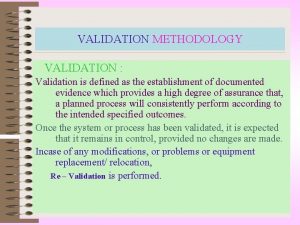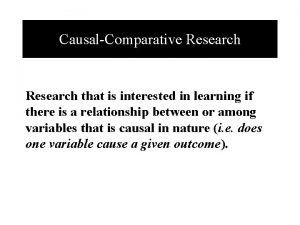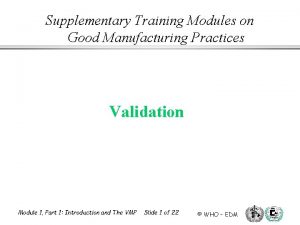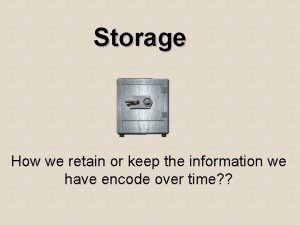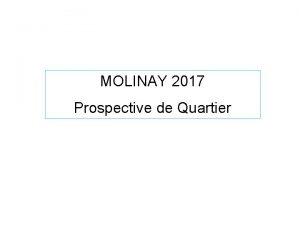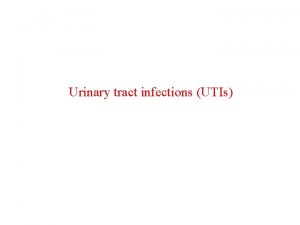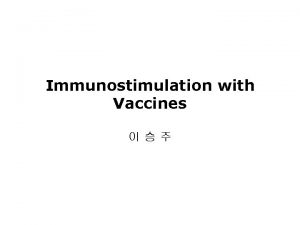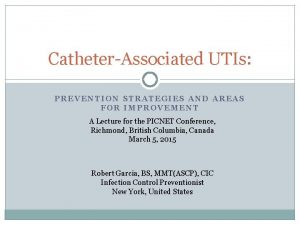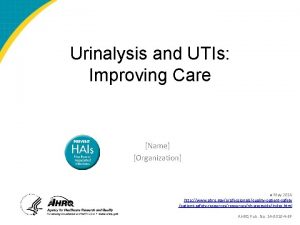UTIs FROM A UROLOGIC PROSPECTIVE Hosam M Tahlawi


































- Slides: 34

“UTIs” FROM A UROLOGIC PROSPECTIVE Hosam M. Tahlawi KAAU Medical School Jeddah, Saudi arabia 1

DEFINITION OF URINARY TRACT INFECTIONS n n UTIs are a group of disorders that share similar clinical manifestations and causative agents. Microbiologically, UTI exists when pathogenic microorganisms are detected in the urine in excess of 100, 000 organism per ml from a properly collected midstream “clean catch” urine. (some authorities use the figure 100 organism per ml + UTI symptoms as enough evidence for diagnosis) 2

Definitions of common infectious syndromes n n n Acute urethral syndrome: dysuria and frequency + or - other bladder or urethral symptoms but “no growth” of bacteria on urine cultures. Acute urethritis: dysuria and urethral discharge with no infection in the bladder. Usually part of STD. Acute pyelonephritis: chills and high fever along with unilateral flank pain + bacteruria and pyuria with white cell casts. 3

Definitions of common infectious syndromes (cont. ) n n n n n Acute prostatitis. prostatodenia Acute epididymitis. Asymptomatic bacteruria. Chronic UTI. Chronic bacterial prostatitis. Chronic abacterial prostatitis Reinfecting recurrent UTI. Relapsing recurrent UTI. 4

Important observations in UTIs n n (1 UTI is the most common bacterial infection of humans of all ages. 2) the incidence, sequelae, and diagnostic considerations of UTI vary with age and sex. 3) the presence of pyuria correlates poorly with the definitive diagnosis of UTI, pyuria may be present I the absence of UTI and vice versa. 4) the history and physical examination alone cannot reliably differentiate upper infection from a lower or urethral one. 5

Important observations in UTIs n n n (5 deep tissue infection of the kidney and prostate and superficial infection of the bladder require different clinical management (6 differentiation between upper and lower infection using noninvasive tests is generally unreliable. (7 Conventional 7 - to 14 -day therapy is not ideal for most forms of UTI, deep tissue infection needs more intensive approach while superficial ones need a less intensive one ( 3 -day therapy is effective in acute uncomplicated UTI in women(. 6

Classifications of UTI n n Anatomical classification. Classification based on the natural history of the UTI for individual patients. 7

Anatomical classification of UTI n n n Upper UTI: include acute and chronic pyelonephritis and renal abscess. Lower UTI: include cystitis and urethritis. Genital UTI: include prostatitis, epididymitis, seminal vesiculitis, and orchitis. 8

UTI based on natural history n n A) First infection: the 1 st documented UTI, and tends to be uncomplicated. B) Unresolved bacteriuria: these are UTI cases where the urinary tract has not been sterilized during therapy. Causes include: – 1) resistance – 2) none compliance – 3) mixed infections – 4) rapid reinfection with resistant bacteria – 5) azotemia – 6) heavily infected staghorn calculi 9

UTI based on natural history (cont. ) n C) Bacterial persistence: cases of UTI where urine cultures become sterile with therapy but with discontinuation it will be reinfected again. Causes include: – 1) infected calculi – 2) chronic prostatitis – 3) unilateral atrophic infected kidney – 4) vasicovaginal or vasicoenteric fistula – 5) obstructive neuropathy – 6) infected polycaliceal diverticula 10

UTI based on natural history (cont. ) n – (7 infected ureteral stumps following nephrectomy for pyelonephritis or pyonephrosis – (8 infected necrotic papilla from papillary necrosis – (9 infected urachal cyst – (10 infected medullary sponge kidney – (11 urethral diverticula – (12 foreign bodies D) Reinfection: cases of UTI with new infection with a new organism after the resolution of a previous infection. 11

Pathogenesis of UTI n (1 Ascending infections: it is clearly the most common cause of genitourinary infections in men and UTI in girls and women. Girls and women are more prone to have UTI because: – A) short urethra (about 4 cm) – B) termination of the urethra beneath the labia – C) proximity to the anus and soiling of the perineum – D) sexual intercourse. (postcoital voiding is protective). – E) absence of prostatic secretions – F) cyclic changes in the mucosal lining 12

Pathogenesis of UTI n n n (2 Hematogenous spread: it is an uncommon event except in tuberculosis, renal abscesses, and perinephric abscesses. NB: UTI itself can cause septicemia. 3) Lymphatogenous spread: it is rare 4) Direct extension from another organ: occur in intraperitoneal abscesses (IBD), fulminant PID, paravesical abscesses, genitourinary tract fistulas , etc. 13

Factors affecting the pathogenesis of UTI n n n n gender and sexual activity: female affected more than the males except in neonates. pregnancy obstruction neurogenic bladder dysfunction vesicoureteral reflux bacterial virulence factors genetic factors 14

Predisposing factors for UTI n Systemic: DM, immunosuppression, malnutrition. n Local: organic or functional obstruction, stasis (residual urine), vesicoureteral reflux, foreign bodies (catheters and stones), tumors or necrotic tissues, and trauma. 15

INVESTIGATIONS IN UROLOGY Start from scratch !? 16

Symptoms in UTI n Systemic: fever, malaise, weight loss, and pain (local or referred). n Related to act of urination: frequency, nocturia, urgency, dysuria, enuresis. n Related to bladder outlet obstruction: hesitancy, loss of force and decreased caliber of stream, terminal dribbling, urgency, acute or chronic urine retention, interruption of urine stream, sense of residual urine. 17

Symptoms in UTI (cont. ) n n n n incontinence oliguria or anuria pneumaturia cloudy urine/ chyluria bloody urine urethral discharge sexual difficulties 18

Urologic examination n n n kidneys bladder penis and vaginal examinations rectal examination lymph nodes neurological examination 19

Urological Investigations. n These fall into two main categories: 1) laboratory investigations. 2) radiological investigations. 20

Urologic laboratory investigations n n Examination of the urine Examination of urethral discharge and vaginal exudates Renal function test Examination of blood, serum, and plasma 21

Examination of the urine n n “The ghosts of dead patients that haunt us do not ask why we did not employ the latest fad of clinical investigations; they ask why did you not test my urine? ” Sir Robert Hutchinson It consists of macroscopic and microscopic examination of clean voided midstream urine. 22

Macroscopic examination n 1) Color and appearance: * red = infection, drugs or blood * cloudy urine = pyuria or tiny stones 2) Smell: is not significant unless it is pungent indicating long stay of the sample, rendering it useless diagnostically 3) Specific gravity: normal (1. 003 -1. 030) dilutional effect on results e. g. pregnancy tests should be considered. 23

Macroscopic examination n 4) Chemical tests: using dip-strip in ER or office settings. – 1) p. H – 2) proteins (+ protein electrophoresis) – 3) glucose – 4) hemoglobin: consider the hemolytic effect of dilute urine. – 5) bacteria (nitrite) needs > 4/24 in the bladder for correct interpretation, so use morning voiding samples – 6) leukocytes (leukocyte esterase) 24

Microscopic examination n n for this test the best sample is the early morning sample that is examined within minutes of collection. The stain used is “Methylene blue” Leukocytes: 5 -8 WBC/ high power field is considered abnormal pyuria. If symptoms of UTI are present, empiric therapy should be commenced. NB: TB produces “sterile” acid pyuria and require Ziehl. Nelson stain for detection. Take into consideration that only 50% will be +ve with spot sample and 70 -80% with 24 hour urine collection sample. 25

Microscopic examination n n Stones: could be the cause of persistent pyuria and warrant KUB (see radiology) RBCs: consider differential diagnosis of hematuria. Use the 3 -container method of urine collection (initial -middle-terminal) to help in localizing the infection. Should be before physical examination especially PR examination. Epithelial cells: apply methylene blue and consult a cytopathologist. Casts: leukocyte, epithelial, hyaline, granular. Others: crystals, artifact (starch from gloves, hair, dirt, . . etc) 26

Microscopic examination n Bacteruria: needs culture for conformation. The culture serves to – 1) quantify bacteria in the urine – 2) know the exact organism(s) involved in the infection – 3) know the susceptibility of these organisms to antibiotics. * Avoid contamination and dilutional effect. * monitor the renal function with therapy !!? 27

Examination of vaginal exudates n vaginal exudate: it is mandatory to examine the vaginal interoitus in patients with symptoms of lower UTI. Some time this examination is enough too establish the diagnosis. Samples are obtained by swabs and sent for culture and sensitivity. 28

Examination of urethral discharge n Use the 4 -container method (VB 1, VB 2, EPS, VB 4) – VB 1 +ve = urethral infection – All VBs +ve = cystitis or upper UTI – EPS & VB 4 = prostatic source of UTI (VB = voiding bladder urine, EPS = expressed prostatic secretions) n All discharges should be examined with methylene blue or gram stain to initially point out the offending organism. If an STD is found then AIDS testing is important otherwise 44% patients with AIDS would be missed at this stage. 29

Renal function test n Renal function test includes: – A) urine specific gravity. – B) serum creatinine: effect of diet and hydration is negligible. – C) endogenous creatinine clearance: it correlates with the GFR and is usually measured after 24 -hour urine collection. Some times it has to be corrected to fit the body built of certain patient as the muscular ones. – D) BUN: affected by diet dehydration and GI bleeding. BUN: creatinine ratio is normally 10: 1 30

Blood, Serum & Plasma n Examination includes: – CBC – PT and PTT – electrolytes – Enzymes: acid phosphatase, ALP – Hormonal studies: PTH, aldosteron, epinephrine, norepinephrine, h. CG, testosterone – Others: fasting blood sugar, uric acid, serum complement. 31

Indications for radiographic examinations n n Radiographic examination is indicated for any patient with UTI whose fever does not resolve after 5 days of adequate antimicrobial therapy, especially if a risk factor is present. Recurrent UTI in males, females or neonates and children is an acceptable indication radiological investigation of the genitourinary tract. 32

Radiological modalities of investigating urological diseases n n plain films of the abdomen (KUB) urography: – – n n n a) intravenous b) retrograde (cystoscopy) c) percutaneous anterograde d) percutaneous retrograde. cystography and voiding cystourethrography uretrography vasography 33

Radiological modalities of investigating urological diseases n lymphangeography. n angiography: – aortorenal & selective renal arteriography – inferior venacavography and selective renal venography – adrenal angiography n n Radiographic subtraction. ultrasonography. Computerized tomography. Magnetic Resonance imaging. 34
 Emt chapter 18 gastrointestinal and urologic emergencies
Emt chapter 18 gastrointestinal and urologic emergencies Types of process validation
Types of process validation Prospective validation
Prospective validation Retrospective goals in conflict
Retrospective goals in conflict Prospective causal-comparative research
Prospective causal-comparative research Longitudinal research design example
Longitudinal research design example Prospective validation
Prospective validation Difference between case control and cohort study
Difference between case control and cohort study Types of longitudinal studies
Types of longitudinal studies Veille prospective
Veille prospective Concurrent validation
Concurrent validation What is case series
What is case series Sciglass
Sciglass Iceberg phenomenon definition
Iceberg phenomenon definition Retrospective cohort study vs prospective cohort study
Retrospective cohort study vs prospective cohort study Prospero systematic review
Prospero systematic review Prospective memory psychology definition
Prospective memory psychology definition Institute for prospective technological studies
Institute for prospective technological studies Prospective analysis financial statements
Prospective analysis financial statements Prospective accounting
Prospective accounting Prospective memory examples
Prospective memory examples

